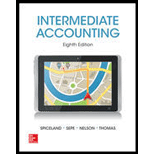
Concept explainers
1.
Deferred tax is an amount i.e. computed on the basis of tax liability on the income as per income statement and the income as per tax return, that difference is known as deferred tax. Deferred tax amount is deferred to the next financial year.
When the Income Tax Expense account i.e. the estimated income tax amount is more than the outstanding amount of income tax i.e. the Income Tax Payable account, the difference is to be debited to Deferred Tax Asset account.
When the Income Tax Expense account i.e. the estimated income tax amount is less than the outstanding amount of income tax i.e. the Income Tax Payable account, the difference is to be credited to Deferred Tax Liability account.
Multiple Temporary Difference
It is very unlikely to have a single temporary difference in any company. In that case, the same concept of temporary difference will be applicable for multiple temporary difference. In case of multiple temporary difference, we have to categorize all temporary difference into future taxable amount and future deductible amounts. The total amount of future taxable amounts multiplied by future tax rate will generate deferred tax liability and total amount of future deductible amount multiplied by future tax rate will generate deferred tax asset.
To prepare: The appropriate
2.
R’s net income for the year 2016
Want to see the full answer?
Check out a sample textbook solution
Chapter 16 Solutions
Intermediate Accounting w/ Annual Report; Connect Access Card
- Pinnacle Corp. reports sales of $15 million for Year 2, with a gross profit margin of 35%. 25% of Pinnacle's sales are on credit. Item Year I Accounts Receivable $200,000 Year 2 $250,000 $1,200,000 $1,500,000 $1,000,000 $1,100,000 Inventory Accounts Payable What is the accounts payable days outstanding at the end of Year 2 for Pinnacle Corp.?arrow_forwardI am searching for the correct answer to this financial accounting problem with proper accounting rules.arrow_forwardCan you help me solve this financial accounting question using valid financial accounting techniques?arrow_forward
- Please explain the solution to this general accounting problem with accurate principles.arrow_forwardPlease provide the accurate answer to this financial accounting problem using appropriate methods.arrow_forwardI am looking for the correct answer to this general accounting question with appropriate explanations.arrow_forward
- Please provide the accurate answer to this general accounting problem using appropriate methods.arrow_forwardPlease explain the solution to this general accounting problem with accurate explanations.arrow_forwardI need guidance with this general accounting problem using the right accounting principles.arrow_forward

 AccountingAccountingISBN:9781337272094Author:WARREN, Carl S., Reeve, James M., Duchac, Jonathan E.Publisher:Cengage Learning,
AccountingAccountingISBN:9781337272094Author:WARREN, Carl S., Reeve, James M., Duchac, Jonathan E.Publisher:Cengage Learning, Accounting Information SystemsAccountingISBN:9781337619202Author:Hall, James A.Publisher:Cengage Learning,
Accounting Information SystemsAccountingISBN:9781337619202Author:Hall, James A.Publisher:Cengage Learning, Horngren's Cost Accounting: A Managerial Emphasis...AccountingISBN:9780134475585Author:Srikant M. Datar, Madhav V. RajanPublisher:PEARSON
Horngren's Cost Accounting: A Managerial Emphasis...AccountingISBN:9780134475585Author:Srikant M. Datar, Madhav V. RajanPublisher:PEARSON Intermediate AccountingAccountingISBN:9781259722660Author:J. David Spiceland, Mark W. Nelson, Wayne M ThomasPublisher:McGraw-Hill Education
Intermediate AccountingAccountingISBN:9781259722660Author:J. David Spiceland, Mark W. Nelson, Wayne M ThomasPublisher:McGraw-Hill Education Financial and Managerial AccountingAccountingISBN:9781259726705Author:John J Wild, Ken W. Shaw, Barbara Chiappetta Fundamental Accounting PrinciplesPublisher:McGraw-Hill Education
Financial and Managerial AccountingAccountingISBN:9781259726705Author:John J Wild, Ken W. Shaw, Barbara Chiappetta Fundamental Accounting PrinciplesPublisher:McGraw-Hill Education





